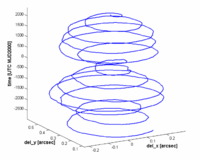Polar motion

Polar motion is like how the Earth wobbles on top of a pole. Imagine holding a spinning top by its stem (the part that sticks out). If you move the top a little bit, it will start wobbling around. This is like what happens to the Earth when it moves a tiny bit, it wobbles too.
The Earth is always spinning around its axis, which is like an imaginary line that goes through the middle of the Earth from the North Pole to the South Pole. But sometimes, the Earth's axis wobbles a tiny bit. This is what we call polar motion. The wobble happens because there are lots of different things that can make the Earth's axis move a little bit.
For example, the wind blowing on the surface of the Earth can make it spin a bit faster or slower, which can cause a wobble. Also, the tides, which are caused by the Moon and the Sun, can push and pull on the Earth, which can also make it wobble around.
Scientists study polar motion very carefully because even a tiny wobble can affect things like how we measure time, or how we navigate using GPS. So by understanding polar motion, we can make sure that our measurements and navigation systems are as accurate as possible.
The Earth is always spinning around its axis, which is like an imaginary line that goes through the middle of the Earth from the North Pole to the South Pole. But sometimes, the Earth's axis wobbles a tiny bit. This is what we call polar motion. The wobble happens because there are lots of different things that can make the Earth's axis move a little bit.
For example, the wind blowing on the surface of the Earth can make it spin a bit faster or slower, which can cause a wobble. Also, the tides, which are caused by the Moon and the Sun, can push and pull on the Earth, which can also make it wobble around.
Scientists study polar motion very carefully because even a tiny wobble can affect things like how we measure time, or how we navigate using GPS. So by understanding polar motion, we can make sure that our measurements and navigation systems are as accurate as possible.
Related topics others have asked about:
